Baseband Receiver Design for Wireless
MIMO-OFDM Communications
�
Baseband Receiver Design for
Wireless MIMO-OFDM
Communications
Second Edition
Tzi-Dar Chiueh
National Taiwan University, Taiwan
Pei-Yun Tsai
National Central University, Taiwan
I-Wei Lai
Academia Sinica, Taiwan
�
This edition first published 2012
© 2012 John Wiley & Sons Singapore Pte. Ltd.
Registered office
John Wiley & Sons Singapore Pte. Ltd., 1 Fusionopolis Walk, #07-01 Solaris South Tower, Singapore
138628
For details of our global editorial offices, for customer services and for information about how to apply for
permission to reuse the copyright material in this book please see our website at www.wiley.com.
All Rights Reserved. No part of this publication may be reproduced, stored in a retrieval system or transmitted, in
any form or by any means, electronic, mechanical, photocopying, recording, scanning, or otherwise, except as
expressly permitted by law, without either the prior written permission of the Publisher, or authorization through
payment of the appropriate photocopy fee to the Copyright Clearance Center. Requests for permission should be
addressed to the Publisher, John Wiley & Sons Singapore Pte. Ltd., 1 Fusionopolis Walk, #07-01 Solaris South
Tower, Singapore 138628, tel: 65-66438000, fax: 65-66438008, email: enquiry@wiley.com.
Wiley also publishes its books in a variety of electronic formats. Some content that appears in print may not be
available in electronic books.
Designations used by companies to distinguish their products are often claimed as trademarks. All brand names and
product names used in this book are trade names, service marks, trademarks or registered trademarks of their
respective owners. The Publisher is not associated with any product or vendor mentioned in this book. This
publication is designed to provide accurate and authoritative information in regard to the subject matter covered. It is
sold on the understanding that the Publisher is not engaged in rendering professional services. If professional advice
or other expert assistance is required, the services of a competent professional should be sought.
Library of Congress Cataloging-in-Publication Data
Chiueh, Tzi-Dar, 1960-
Baseband receiver design for wireless MIMO-OFDM communications / Tzi-Dar Chiueh, Pei-Yun Tsai,
I-Wei Lai. – 2nd ed.
p. cm.
Rev. ed. of: OFDM baseband receiver design for wireless communications / Tzi-Dar Chiueh,
Pei-Yun Tsai. c2007.
Includes bibliographical references and index.
ISBN 978-1-118-18818-7 (cloth)
1. Radio–Transmitter-receivers.
3. Orthogonal frequency division multiplexing.
III. Lai, I-Wei, 1960- OFDM baseband receiver design for wireless communications. IV. Title.
2. Wireless communication systems–Equipment and supplies.
TK5103.2.C4657 2012
621.384’18–dc23
Set in 10/12 pt Times by Thomson Digital, Noida, India
4. MIMO systems.
I. Chiueh, Tzi-Dar.
II. Tsai, Pei-Yun.
2012000095
�
To my Dad Chin-Mu, my wife Jill, my daughter Joanne, and my son Kevin.
— Tzi-Dar Chiueh
To my families for their constant encouragement and support.
— Pei-Yun Tsai
To my dear parents, Yun-Tai and Hui-Chin, and my lovely sisters.
— I-Wei Lai
�
Contents
Preface
About the Authors
Acknowledgements
List of Abbreviations and Acronyms
PART ONE: FUNDAMENTALS OF WIRELESS COMMUNICATION
1.
Introduction
1.1
Digital Broadcasting Systems
1.1.1 Digital Audio Broadcasting (DAB)
1.1.2 Digital Video Broadcasting (DVB)
1.2 Mobile Cellular Systems
1.2.1 Carrier Aggregation
1.2.2 Multiple-Antenna Configuration
1.2.3 Relay Transmission
1.2.4 Coordinated Multipoint Transmission and Reception (CoMP)
1.3 Wireless Network Systems
1.3.1 Personal Area Network (PAN)
1.3.2 Local Area Network (LAN)
1.3.3 Metropolitan Area Network (MAN)
1.3.4 Wide Area Network (WAN)
Summary
References
xiii
xvii
xix
xxi
3
3
4
4
6
8
8
9
9
10
10
12
13
14
14
15
�
viii
2. Digital Modulation
2.1
Single-Carrier Modulation
2.1.1 Power Spectral Densities of Modulation Signals
2.1.2 PSK, QAM, and ASK
2.1.3 CPFSK and MSK
2.1.4 Pulse Shaping and Windowing
2.2 Multi-Carrier Modulation
2.2.1 Orthogonal Frequency-Division Multiplexing
2.2.2 OFDM Related Issues
2.2.3 OFDM Transceiver Architecture
Adaptive OFDM
2.3
Summary
References
3. Advanced Wireless Technology
3.1 Multiple-Input Multiple-Output (MIMO)
3.1.1 Introduction
3.1.2 MIMO Basics
3.1.3 MIMO Techniques
3.1.4 MIMO-OFDM System Example
3.2 Multiple Access
3.2.1 Frequency-Division Multiple Access (FDMA)
3.2.2 Time-Division Multiple Access (TDMA)
3.2.3 Code-Division Multiple Access (CDMA)
3.2.4 Carrier Sense Multiple Access (CSMA)
3.2.5 Orthogonal Frequency-Division Multiple Access (OFDMA)
3.2.6 Space-Division Multiple Access (SDMA)
Spread Spectrum and CDMA
3.3.1 PN Codes
3.3.2 Direct-Sequence Spread Spectrum
3.3.3 Frequency-Hopping Spread Spectrum
3.3
Summary
References
4. Error-Correcting Codes
4.1
4.2
4.3
Introduction
Block Codes
4.2.1 Linear Codes
4.2.2 Cyclic Codes
Reed–Solomon Codes
4.3.1 Finite Fields
4.3.2 Encoding
4.3.3 Decoding
4.3.4 Shortened Reed–Solomon Codes
Contents
17
17
18
19
22
23
24
27
27
31
33
37
37
39
39
39
41
43
50
53
54
54
55
57
57
58
59
60
63
65
66
67
69
69
70
70
72
73
74
75
76
76
�
Contents
4.4
4.5
4.6
4.7
Convolutional Codes
4.4.1 Encoding
4.4.2 Viterbi Decoder
4.4.3 Punctured Convolutional Codes
Soft-Input Soft-Output Decoding Algorithms
4.5.1 MAP Decoder
4.5.2 Log-MAP Decoder
4.5.3 Max-Log-MAP Decoder
Turbo Codes
4.6.1 Encoding
4.6.2 Decoding
Low-Density Parity-Check Codes
4.7.1 Encoding
4.7.2 Decoding
Summary
References
5. Signal Propagation and Channel Model
Introduction
5.1
5.2 Wireless Channel Propagation
5.2.1 Path Loss and Shadowing
5.2.2 Multipath Fading
5.2.3 Multipath Channel Parameters
5.2.4 MIMO Channel
Front-End Electronics Effects
5.3.1 Carrier Frequency Offset
5.3.2 Sampling Clock Offset
5.3.3 Phase Noise
5.3.4 IQ Imbalance and DC Offset
5.3.5 Power Amplifier Nonlinearity
Channel Model
5.4.1 Model for Front-End Impairments
5.4.2 Multipath Rayleigh Fader Model
5.4.3 Channel Models Used in Standards
5.3
5.4
Summary
References
PART TWO: MIMO-OFDM RECEIVER PROCESSING
6. Synchronization
6.1
6.2
Introduction
Synchronization Issues
6.2.1 Synchronization Errors
6.2.2 Effects of Synchronization Errors
6.2.3 Consideration for Estimation and Compensation
ix
77
77
79
80
81
82
85
86
87
87
88
89
89
91
93
94
95
95
96
96
97
98
104
105
105
106
106
107
110
111
112
113
116
122
123
127
127
128
128
128
133
�
x
Contents
6.3
6.4
6.5
Detection and Estimation of Synchronization Errors
6.3.1 Symbol Timing Detection
6.3.2 Carrier Frequency Offset Estimation
6.3.3 Residual CFO and SCO Estimation
6.3.4 Carrier Phase Estimation
6.3.5 IQ Imbalance Estimation
Detection and Estimation of Synchronization Errors in
MIMO-OFDM Systems
6.4.1 Symbol Timing Detection in MIMO-OFDM Systems
6.4.2 Carrier Frequency Offset Estimation in MIMO-OFDM Systems
6.4.3 Residual CFO and SCO Estimation in MIMO-OFDM Systems
6.4.4 Carrier Phase Estimation in MIMO-OFDM Systems
6.4.5 IQ Imbalance Estimation in MIMO-OFDM Systems
Recovery of Synchronization Errors
6.5.1 Carrier Frequency Offset Compensation
6.5.2 Sampling Clock Offset and Common Phase Error Compensation
6.5.3 IQ Imbalance Compensation
Summary
References
7. Channel Estimation and Equalization
7.1
7.2
7.3
Introduction
Pilot Pattern
7.2.1 Pilot Pattern in SISO-OFDM Systems
7.2.2 Pilot Pattern in MIMO-OFDM Systems
SISO-OFDM Channel Estimation
7.3.1 Channel Estimation by Block-Type Pilot Symbols
7.3.2 Channel Estimation by Comb-Type Pilot Symbols
7.3.3 Channel Estimation by Grid-Type Pilot Symbols
7.4 MIMO-OFDM Channel Estimation
7.5
7.6
7.7
7.4.1 Space–Time Pilot
Adaptive Channel Estimation
Equalization
7.6.1 One-Tap Equalizer
7.6.2 Multi-Tap Equalizer
Iterative Receiver
7.7.1 Iterative Synchronization and Channel Estimation
7.7.2 Bit-Interleaved Coded Modulation with Iterative
Decoding (BICM-ID)
Summary
References
8. MIMO Detection
8.1
8.2
Introduction
Linear Detection
134
134
143
147
149
150
153
153
155
156
157
157
158
158
160
163
163
164
167
167
168
168
171
174
177
179
186
191
191
194
195
195
198
204
205
205
206
207
209
209
210
�
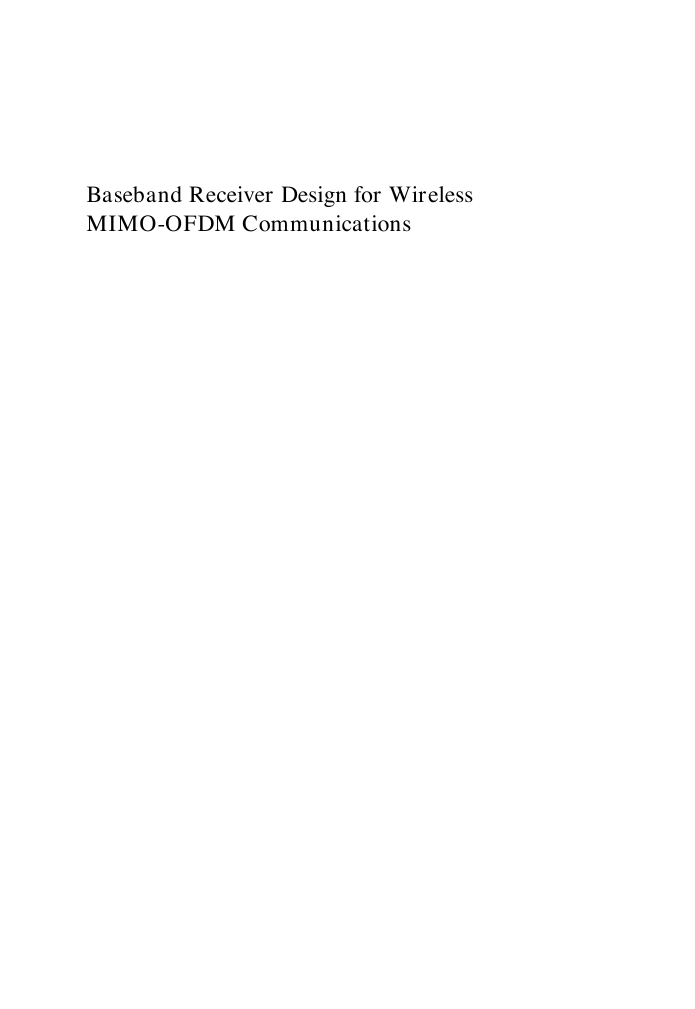
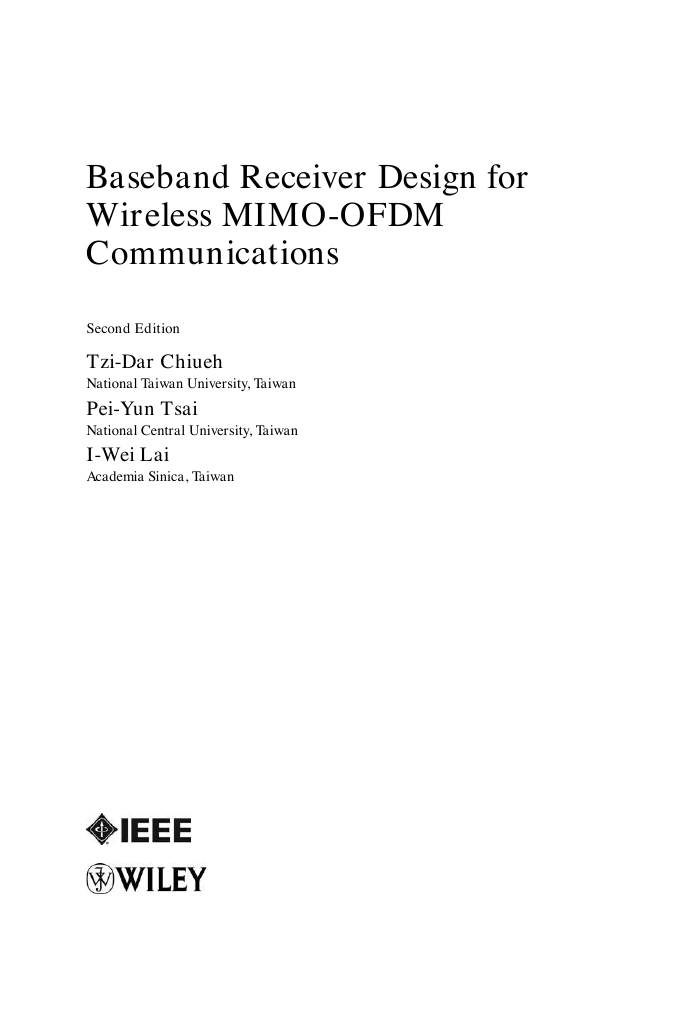
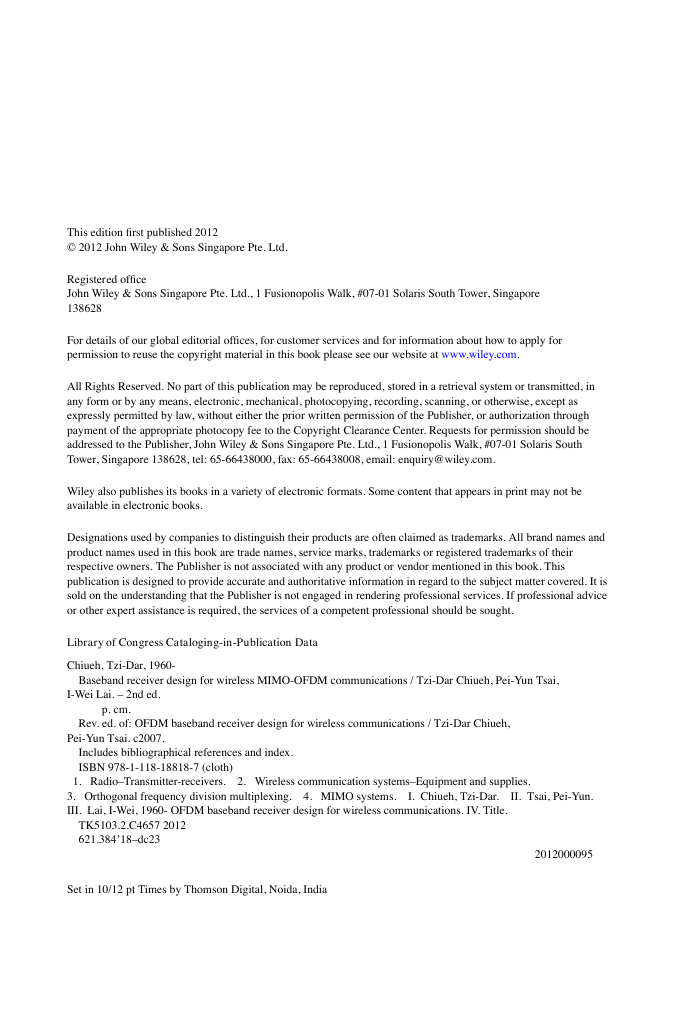
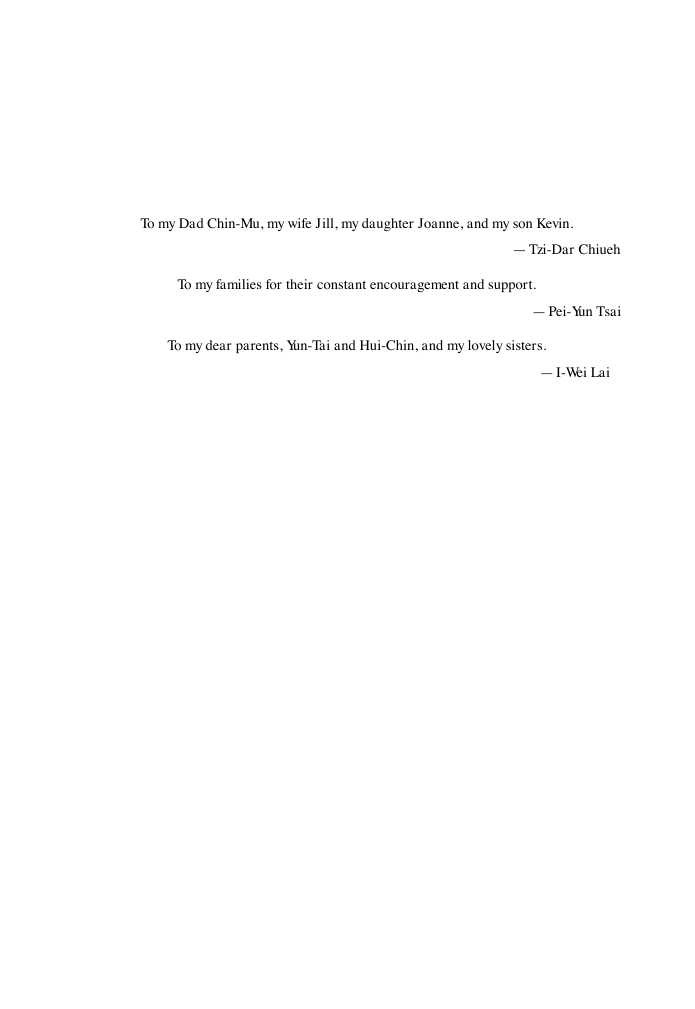

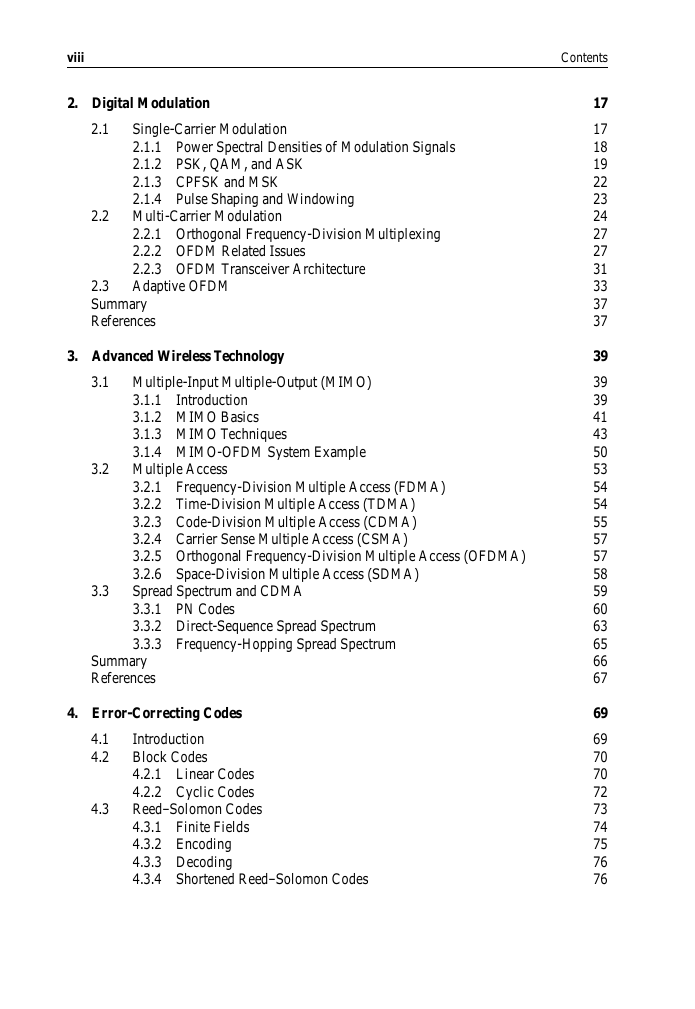
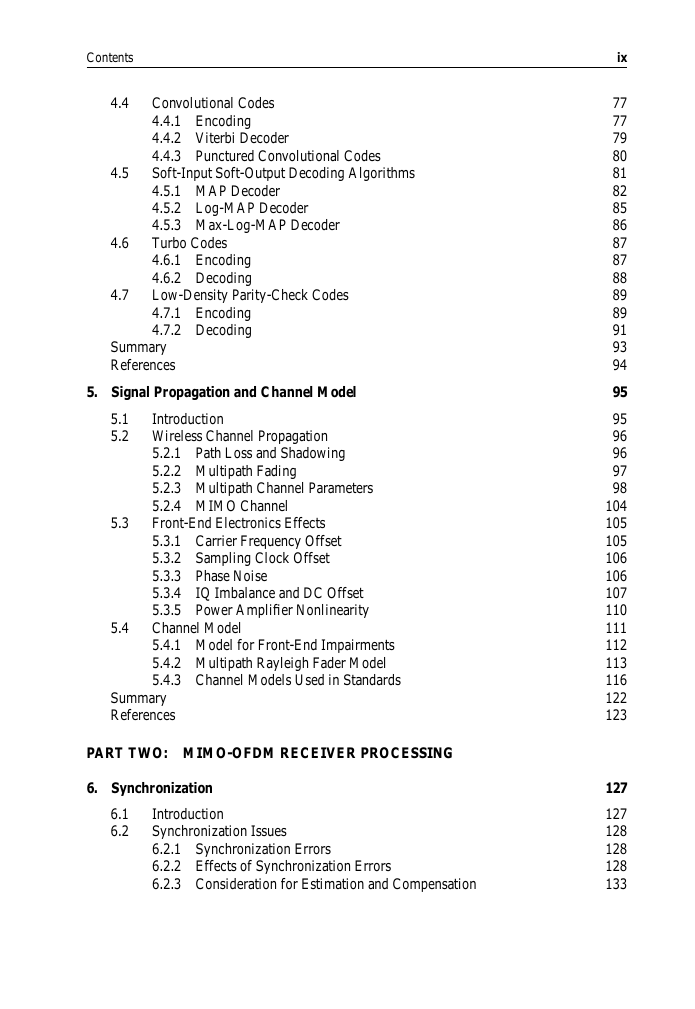
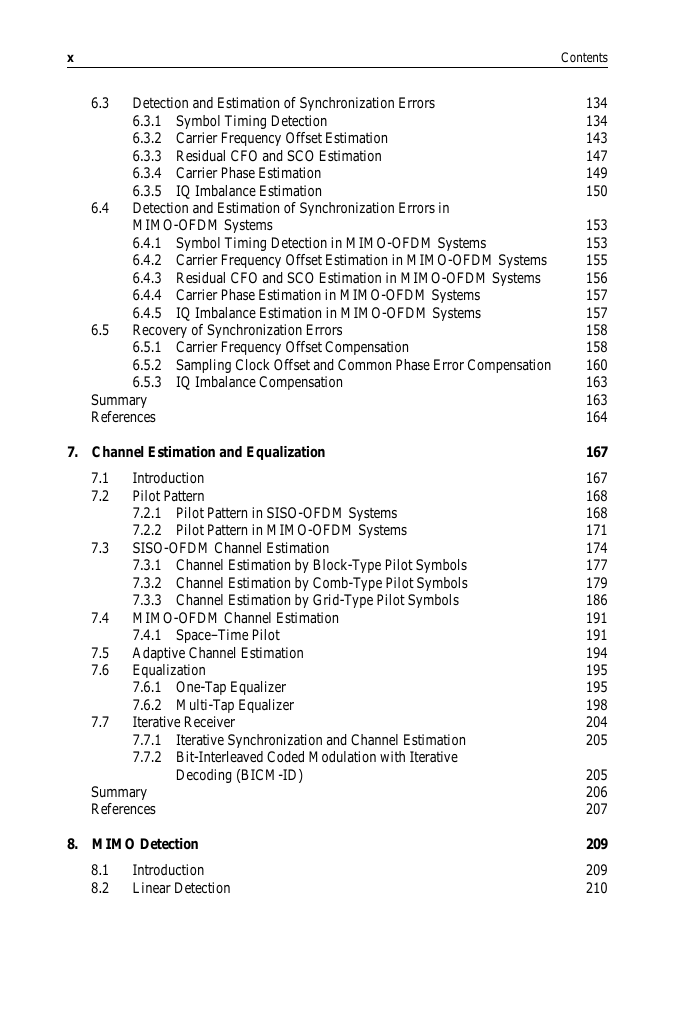








 2023年江西萍乡中考道德与法治真题及答案.doc
2023年江西萍乡中考道德与法治真题及答案.doc 2012年重庆南川中考生物真题及答案.doc
2012年重庆南川中考生物真题及答案.doc 2013年江西师范大学地理学综合及文艺理论基础考研真题.doc
2013年江西师范大学地理学综合及文艺理论基础考研真题.doc 2020年四川甘孜小升初语文真题及答案I卷.doc
2020年四川甘孜小升初语文真题及答案I卷.doc 2020年注册岩土工程师专业基础考试真题及答案.doc
2020年注册岩土工程师专业基础考试真题及答案.doc 2023-2024学年福建省厦门市九年级上学期数学月考试题及答案.doc
2023-2024学年福建省厦门市九年级上学期数学月考试题及答案.doc 2021-2022学年辽宁省沈阳市大东区九年级上学期语文期末试题及答案.doc
2021-2022学年辽宁省沈阳市大东区九年级上学期语文期末试题及答案.doc 2022-2023学年北京东城区初三第一学期物理期末试卷及答案.doc
2022-2023学年北京东城区初三第一学期物理期末试卷及答案.doc 2018上半年江西教师资格初中地理学科知识与教学能力真题及答案.doc
2018上半年江西教师资格初中地理学科知识与教学能力真题及答案.doc 2012年河北国家公务员申论考试真题及答案-省级.doc
2012年河北国家公务员申论考试真题及答案-省级.doc 2020-2021学年江苏省扬州市江都区邵樊片九年级上学期数学第一次质量检测试题及答案.doc
2020-2021学年江苏省扬州市江都区邵樊片九年级上学期数学第一次质量检测试题及答案.doc 2022下半年黑龙江教师资格证中学综合素质真题及答案.doc
2022下半年黑龙江教师资格证中学综合素质真题及答案.doc